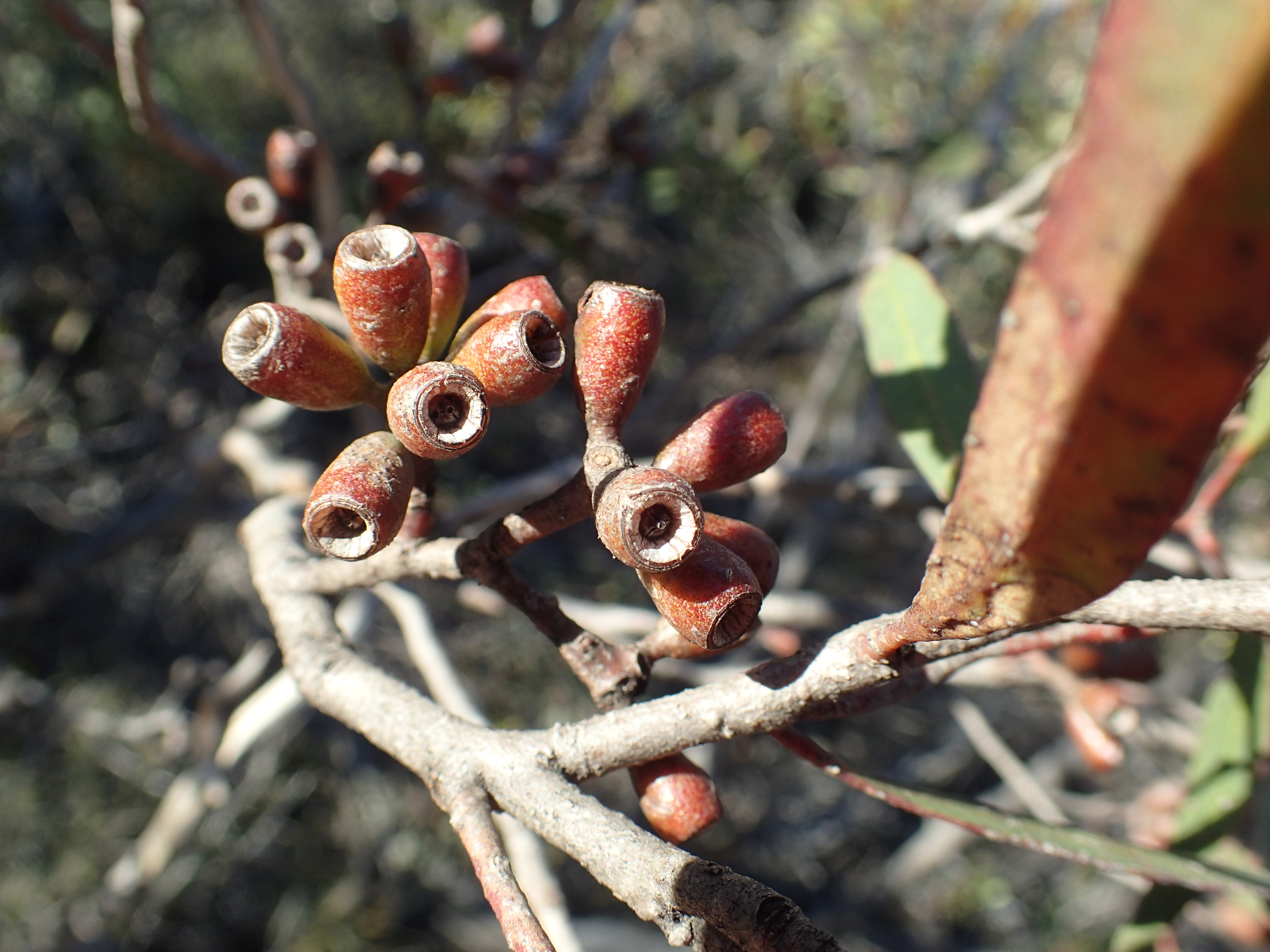Eucalyptus clivicola on:
[Wikipedia]
[Google]
[Amazon]
''Eucalyptus clivicola'', commonly known as green mallet, is a species of eucalypt that is 

endemic
Endemism is the state of a species being found in a single defined geographic location, such as an island, state, nation, country or other defined zone; organisms that are indigenous to a place are not endemic to it if they are also found elsew ...
to Western Australia
Western Australia (commonly abbreviated as WA) is a state of Australia occupying the western percent of the land area of Australia excluding external territories. It is bounded by the Indian Ocean to the north and west, the Southern Ocean to th ...
. It has smooth bark, linear to lance-shaped adult leaves, flower buds in groups of between nine and thirteen, pale yellow flowers and barrel-shaped, conical or cylindrical fruit.

Description
''Eucalyptus clivicola'' is a mallet that typically grows to a height of and rarely forms a lignotuber. It has smooth grey over yellowish bark with flakes of rough, greyish bark that has not been completely shed. Its adult leaves are linear to lance-shaped, long and wide on a petiole long. The flower buds are arranged in groups of between nine and thirteen on a peduncle long that widens near the end, the individual buds on apedicel
Pedicle or pedicel may refer to:
Human anatomy
*Pedicle of vertebral arch, the segment between the transverse process and the vertebral body, and is often used as a radiographic marker and entry point in vertebroplasty and kyphoplasty procedures
...
long. Mature buds are top-shaped to elongated, long and wide with a conical to horn-shaped operculum up to three times as long as the floral cup
In angiosperms, a hypanthium or floral cup is a structure where basal portions of the calyx, the corolla, and the stamens form a cup-shaped tube. It is sometimes called a floral tube, a term that is also used for corolla tube and calyx tube. It ...
. Flowering occurs from December to May and the flowers are pale yellow. The fruit is a woody, barrel-shaped, to conical or cylindrical capsule long and wide.
Taxonomy and naming
''Eucalyptus clivicola'' was first formally described in 1991 by Ian Brooker andStephen Hopper
Stephen Donald Hopper AC FLS FTSE (born 18 June 1951) is a Western Australian botanist. He graduated in Biology, specialising in conservation biology and vascular plants. Hopper has written eight books, and has over 200 publications to his n ...
from a specimen on the Ravensthorpe Ravensthorpe may refer to any of the following places.
England
*Ravensthorpe, Dewsbury in West Yorkshire
**Ravensthorpe railway station, Dewsbury
*Ravensthorpe, Northamptonshire
*Ravensthorpe, Peterborough in Cambridgeshire
*Ravensthorpe, an histor ...
- Hopetoun road and the description was publish in the journal ''Nuytsia
''Nuytsia floribunda'' is a hemiparasitic tree found in Western Australia. The species is known locally as moodjar and, more recently, the Christmas tree or Western Australian Christmas tree. The display of intensely bright flowers during the ...
''. The specific epithet
In taxonomy, binomial nomenclature ("two-term naming system"), also called nomenclature ("two-name naming system") or binary nomenclature, is a formal system of naming species of living things by giving each a name composed of two parts, bot ...
(''clivicola'') is derived from the Latin
Latin (, or , ) is a classical language belonging to the Italic branch of the Indo-European languages. Latin was originally a dialect spoken in the lower Tiber area (then known as Latium) around present-day Rome, but through the power of the ...
word ''clivus'' meaning "ascent", "elevation", "hill" or "sloping hillside" with the suffix
In linguistics, a suffix is an affix which is placed after the stem of a word. Common examples are case endings, which indicate the grammatical case of nouns, adjectives, and verb endings, which form the conjugation of verbs. Suffixes can carry ...
''-cola'' meaning "dweller", referring to the usual habitat of this species.
Distribution and habitat
Green mallet often grows in pure stands of open forest on breakaways, rarely on flat ground. It occurs between Ongerup, Ravensthorpe and Lake Magenta in theEsperance Plains
Esperance Plains, also known as Eyre Botanical District, is a biogeographic region in southern Western Australia on the south coast between the Avon Wheatbelt and Hampton bioregions, and bordered to the north by the Mallee region. It is a pl ...
and Mallee biogeographic regions
A biogeographic realm or ecozone is the broadest biogeographic division of Earth's land surface, based on distributional patterns of terrestrial organisms. They are subdivided into bioregions, which are further subdivided into ecoregions.
De ...
.
Conservation status
This eucalypt is classified as "not threatened" by the Western Australian GovernmentDepartment of Parks and Wildlife
The Department of Parks and Wildlife (DPaW) was the department of the Government of Western Australia responsible for managing lands described in the ''Conservation and Land Management Act 1984'' and implementing the state's conservation and e ...
.
See also
* List of ''Eucalyptus'' speciesReferences
{{Taxonbar, from=Q15396045 clivicola Endemic flora of Western Australia Mallees (habit) Myrtales of Australia Eucalypts of Western Australia Goldfields-Esperance Great Southern (Western Australia) Taxa named by Ian Brooker Taxa named by Stephen Hopper Plants described in 1991